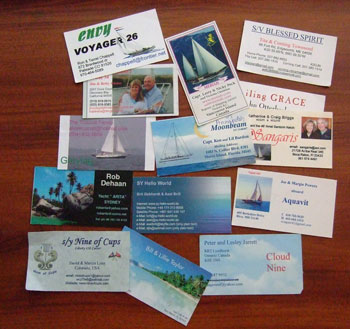 The ease with which we meet fellow cruisers and the speed with which we befriend them is counterbalanced to some extent by the difficulty of keeping track of them all.
The ease with which we meet fellow cruisers and the speed with which we befriend them is counterbalanced to some extent by the difficulty of keeping track of them all.
On the one hand there is the memory game of sorting out and remembering all the folks you just met at a potluck, while on the other is the challenge of staying connected to the ones you’ve become close to when ways part.
Gone are the usual criteria by which we customarily organize acquaintances: their address, phone number, workplace,… their LAST NAME!
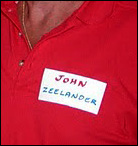 Instead we must learn to think of them by first names, boat names, boat type, homeport, radio call signs and – the most amorphous of criteria – their planned itinerary. Itinerary matters, because we cruisers do factor into the investment of attention we’re willing to give a new friendship the likelihood of our seeing them again.
Instead we must learn to think of them by first names, boat names, boat type, homeport, radio call signs and – the most amorphous of criteria – their planned itinerary. Itinerary matters, because we cruisers do factor into the investment of attention we’re willing to give a new friendship the likelihood of our seeing them again.
The most important tool you have for remembering the people you meet (and being remembered by them!) is the boat card, promptly exchanged. You can have some fun in designing these, however, you need to give careful consideration to the information you want to put on it, depending on what you want to put out there for the world to see.
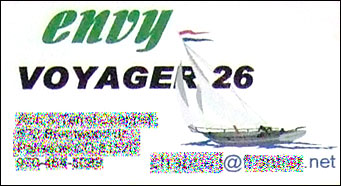 Commonly you will see any or all of the following: Boat name, crew names, hailing port, call sign(s), radio email address, DSC number (for digital selection calling via the VHF), land email address, mailing address, and boating associations belonged to. If you have a captain’s license and hope to do deliveries, you might put that on. Likewise if you have skill as a mechanic, seamstress, sailmaker, rigger or any cruising-related profession you want to market to other cruisers (don’t forget computer sorter-outer), you might want to include that! Finally, a picture of the boat or you is really helpful for people like me. Yes, all that on a 2”x3.5” card!
Commonly you will see any or all of the following: Boat name, crew names, hailing port, call sign(s), radio email address, DSC number (for digital selection calling via the VHF), land email address, mailing address, and boating associations belonged to. If you have a captain’s license and hope to do deliveries, you might put that on. Likewise if you have skill as a mechanic, seamstress, sailmaker, rigger or any cruising-related profession you want to market to other cruisers (don’t forget computer sorter-outer), you might want to include that! Finally, a picture of the boat or you is really helpful for people like me. Yes, all that on a 2”x3.5” card!
Some cruisers are private or cautious (or both) about sharing personal data, while others are more forward. One thing you want to be careful about spreading around is your radio email address, which you want to guard against getting on bulk mailing or spam lists.
On the other hand your email address is the best way for you to keep connected. A solution may be to have two cards, one with more info and with less. Either way, consider that you probably don’t want to print off a thousand glossy cards when first starting out, because information you want to share may change. Onboard printers and standard-size Avery card stock is a good compromise.
Other strategies for learning new names in an anchorage are to keep a list by the companionway that you add to daily or to enter names or paste boat cards into your log (or guest) book with pertinent notes about how you met. Many cruisers snap digital photos to aid their memories. The logbook option works well for Lisa of LADY GALADRIEL, because, like many people, “Associating where and what was happening when I met someone really helps me remember them.”
No matter how strong the connection you’ve just made with someone, chances are you’ll go in opposite directions sooner or later. It’s important not to take this personally. Cruisers are an independent breed, and part of the joy of cruising is the ability to peel off on your own whenever you wish and rejoin the crowd somewhere else.
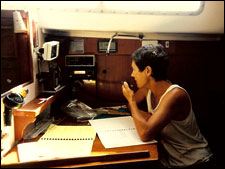 This is why, in the era of satellite phones, so many cruisers feel so strongly about the value of having an HF (SSB/Ham) radio on board. “A satellite phone can connect you to the outside world,” says Kathy of HALE KAI, “but an HF radio connects you to your community.” At $1 a minute, cruisers don’t sit around chatting with each other on their Iridium phones.
This is why, in the era of satellite phones, so many cruisers feel so strongly about the value of having an HF (SSB/Ham) radio on board. “A satellite phone can connect you to the outside world,” says Kathy of HALE KAI, “but an HF radio connects you to your community.” At $1 a minute, cruisers don’t sit around chatting with each other on their Iridium phones.
Given that, another good place to keep a list of names handy is with your radio log.
“The regional radio nets are a great way to stay connected to cruising friends,” adds Lisa, who has been an active net controller in several cruising grounds. “The morning check-in lets you track where people are and the contact section lets you arrange your next rendezvous. You even absorb information about people you haven’t yet met.”
The regional nets aren’t the only way to use radio. Often, especially on passages, friends wanting to keep in closer touch setup a regular radio schedule on an agreed upon frequency. As your friendship group expands, so does the mini-net.
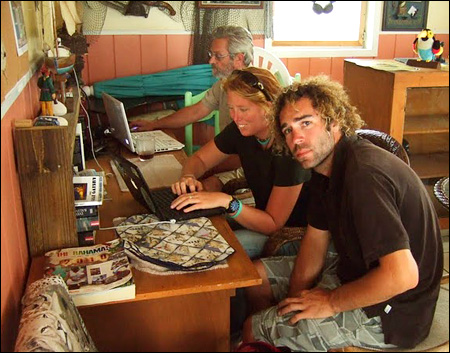 When distances grow greater, email steps into the breach. When both boats have onboard email capability, this enables quick communication. If one boat or both rely on land internet, however, connecting by email contact becomes less spontaneous.
When distances grow greater, email steps into the breach. When both boats have onboard email capability, this enables quick communication. If one boat or both rely on land internet, however, connecting by email contact becomes less spontaneous.
There comes a threshold of time and distance where even personal emails drop off, yet you still don’t want to lose touch. Newsletters, composed and sent to a list of friends (often at Christmas), are a common answer to this urge. Newsletters sum up the salient points of recent travels so that recipients can act on them if relevant to their own voyage. Websites and blogs really don’t do this as well between cruisers as they do between you and people back home for the simple reason that most cruisers don’t have enough Internet access to follow them.
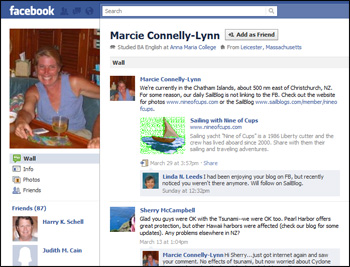 Facebook, on the other hand, does it very well, and cruisers have quickly flocked to the social networking machine. Facebook’s brief posts and easy uploading for photographs work great at keeping the embers of friendship updated and glowing across gaps of time and distance, plus, of course, Facebook makes it easy to find lost friends wherever they may be in the world. “Through Facebook the last couple of years,” recounts Marcie of NINE OF CUPS, “I’ve reconnected with cruisers I met years ago that I’d lost contact with. It was such a gift to reconnect with those people that I share wonderful memories with.”
Facebook, on the other hand, does it very well, and cruisers have quickly flocked to the social networking machine. Facebook’s brief posts and easy uploading for photographs work great at keeping the embers of friendship updated and glowing across gaps of time and distance, plus, of course, Facebook makes it easy to find lost friends wherever they may be in the world. “Through Facebook the last couple of years,” recounts Marcie of NINE OF CUPS, “I’ve reconnected with cruisers I met years ago that I’d lost contact with. It was such a gift to reconnect with those people that I share wonderful memories with.”
Likewise Skype was adopted by cruisers well before the mainstream, and it is the ultimate in keeping connected across great distances. Whether computer-to-computer (free) or computer-to-phone (a very small charge), Skype has returned the intimacy of a voice call (not to mention video face-to-face time) to cruisers’ lives. I am regularly in touch with friends in Bahamas, Mexico, Fiji and Australia.
Why go to all this trouble to sustain so seemingly intangible a network of connections? Lorraine of TWIST OF FATE spoke for all the Admirals when she said, “The thrill of running into cruising friends again, even years later, even ashore, is wonderful. We catch up and reestablish that same closeness again easily, as if no time at all has passed.”
And thank God for that! In the past year alone we have had no fewer than a dozen good cruising friends stop by here in Florida for a visit – from the Virgin Islands, New Zealand, Alabama, Washington State, Colombia, Fiji, and California, among others.
“I see my cruising connections as giving me a lifetime of places to visit and/or compatible people to travel with,” says Kathy of HALE KAI, who’s pretty much ready to travel anywhere, anytime, with or without the boat. “Even if I can’t always stay with friends, at least I always have people to meet up with and locals to advise me on the best things to do there. I don’t have to feel like a stranger in a strange land.”
I think, again, this is so, because cruising friends GET IT. They know and never forget all of those shared experiences – the shared destinations, activities, projects, weather and, of course, adversities so unique to cruising – as well as the urge for exploration that drove us to have those cruising experiences in the first place.
Photos: Thanks to Kathy Parsons, Hale Kai
Contributing Admirals: Lisa Schofield, LADY GALADRIEL; Mary Heckrotte, CAMRYKA; Marcie Lynn, NINE OF CUPS; Jane Kilburn, LIONHEART; Kathy Parsons, HALE KAI; Debbie Leisure, ILLUSIONS; Ellen Sanpere, CAYENNE III; Lorraine Bramble, TWIST OF FATE; Sylvie Branton, ALBATROS.
This article was published in the March 2011 issue of Latitudes and Attitudes.
Related articles on this website
- Cruising Friendships, Part One (Admiral’s Angle column #55): Cruising friendships grow quickly from the lifestyle’s many meeting opportunities.
- The Knack of Befriending Locals (Admiral’s Angle column #57): What’s behind the knack of forging successful bonds with local peoples in the places we visit.
- Logs and Blogs (Admiral’s Angle column #37):The tradition of recording voyage experiences doesn’t just preserve memories but encourages others to follow.
- Staying in Touch (Admiral’s Angle column #14): Out of sight of land no longer means out of touch: the ways and means cruisers stay in touch with each other and back home.
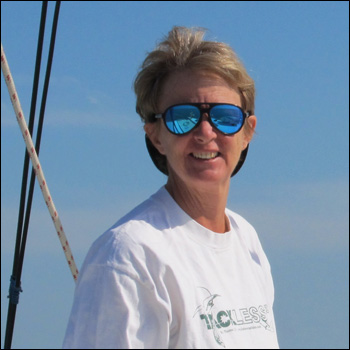
Love this series!! I also wrote about cruising friendships (though nowhere near as in-depth!). http://windtraveler.blogspot.com/2011/04/cruising-friends.html
I have a question about Boat cards: What is the proper etiquette regarding name & designation of our vessel on the card? I can’t seem to find any info on it, and I would hate to offend by being ignorant!
Hi Laurie, I wouldn’t say there is any “proper” etiquette for boat cards. These days, cruisers get pretty creative!
Typically, people include their boat name, their own names, homeport (if
your homeport is actually connected to you…rather than say Wilmington, DE
as a corporate base), and some means of getting in touch, e.g. email
address. Also, cruisers usually choose some way to help people recollect
them from the crowd, e.g. the type of boat your boat is, a picture of the
boat, a picture of YOU, etc. My first cards used a graphic that suggested
that we were sailors and scuba divers; later I used a photo of our boat
under sail. Do try to keep the card in standard business card size and shape,
because it simplifies keeping track of all the ones you collect.
Gwen